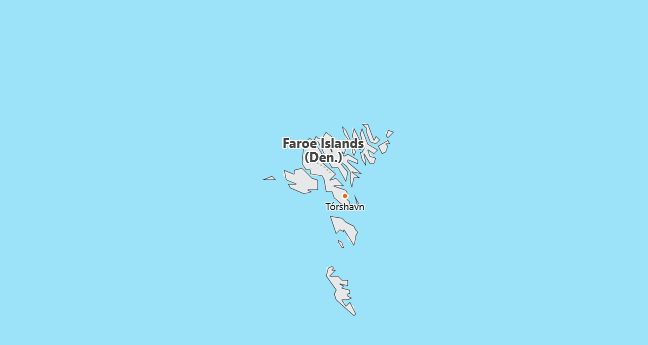Faroe Islands Facts
Faroe Islands, archipelago in the North Atlantic, between Scotland and Iceland; 1,400 km², 49,755 residents (2016).The archipelago forms part of Denmark but has internal autonomy. The Faroe Islands, which extend about 113 km in the north-south direction and 75 km in the west-east direction, consist of 17 inhabited islands and a number of more or less inaccessible small islands. The largest islands are Streymoy (Danish Strømø) 373 km 2, Eysturoy (Danish Østerø) 286 km 2, Vágar (Danish Vågø) 178 km 2, Suðuroy (Danish Suderø) 166 km 2 and Sandoy (Danish Sandø) 112 km 2. The capital is Tórshavn (Danish Thorshavn), located on Streymoy, 12,200 residents (2013). Administratively, the Faroe Islands are divided into six counties (counties).
Faroe Islands Flag

Country facts
- Føroyar
- Country abbreviation: FO
- Area: 1 400 km²
- Population (2016): 49,755 residents
- Capital: Torshavn
- Main languages: Faroese, Danish
- State condition: autonomous part of the Kingdom of Denmark
- Head of State: Margrethe II (Queen)
- Head of Government: Aksel V. Johannesen
- Per capita GDP (2014): US $ 36,600
- Currency unit: 1 Danish krona = 100 öre
- Currency code: DKK
- Internet domain name: fo
- Time difference compared to Sweden: −1
- National Day: July 29 (Olaifesten)
Nature
- Highest Rock: Mowing Peak (882 m asl)
Population
- Population density (2016): 36 residents per km²
- Natural population growth (2016): 0.5%; birth rate 14 ‰, death rate 9 ‰
- Age structure (2016): 0-14 years (20%), 15-64 (64%), 65- (16%)
- Average life expectancy (2016): 80 years; men 78 years, women 83 years
- Infant mortality (2016): 6 per 1,000 live births
- Urbanization rate (2016): 42%
- Most populous city (2013): Tórshavn (12,200 residents)
Business
- Industry’s contribution to GDP (2012): agriculture (16%), industry (29%), service (55%)
- Main export product: fish
- Main export partners: Denmark, UK, USA
- Main import products: machinery, transport, food
- Main import partners: Denmark, Norway, Iceland
Communications
- Railway network: nothing in operation
- Road network (2015): 960 km
- Internet users per 100 residents (2015): 94
Faroe Islands Map














































